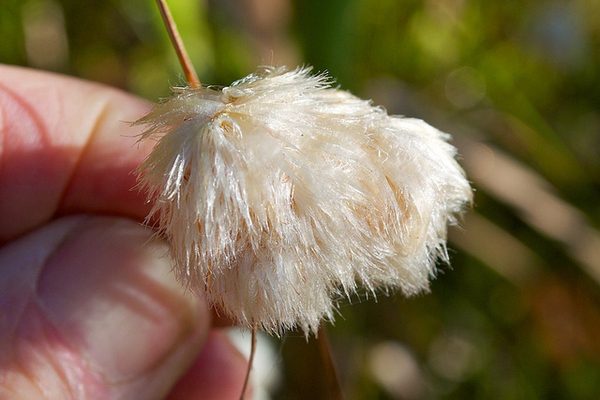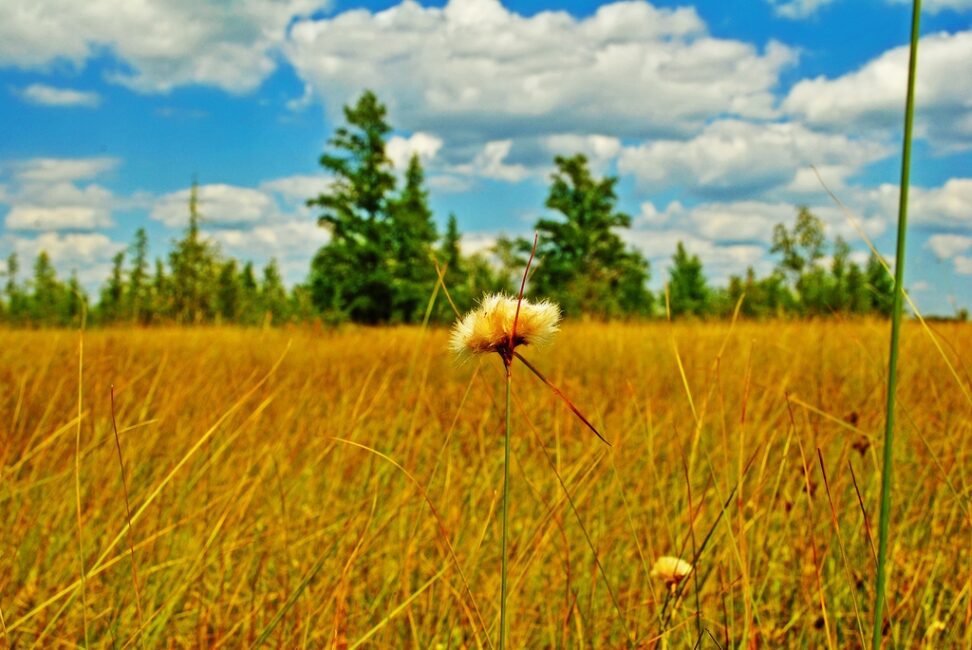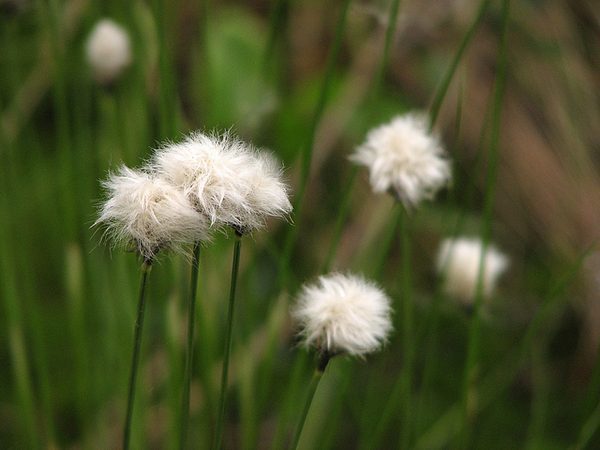Tawny cottongrass, scientifically known as Eriophorum virginicum, is a distinctive and fascinating wetland plant that can be found in various regions.
Tawny cottongrass, scientifically referred to as Eriophorum virginicum, is a remarkable wetland plant known for its striking appearance and ecological significance. This plant is native to wetland habitats, particularly in North America, where it thrives in boggy and marshy areas.
This plant forms tufts of slender, grass-like leaves that grow upright from the wetland substrate. These tufts can create a visually striking effect in wetland landscapes.
In late spring to early summer, Tawny cottongrass produces tall flowering stalks, which can reach heights of up to two feet. These stalks are topped with delicate, cotton-like seed heads, which are its most iconic feature.
The seed heads of Tawny cottongrass resemble fluffy cotton balls, giving the plant its common name. These cotton-like structures are adaptations for wind dispersal of seeds, allowing the plant to propagate in its wetland habitat.
Wetland birds, such as waterfowl and shorebirds, often use Tawny cottongrass tufts as nesting sites. The dense growth provides shelter and protection for their nests and young.
Tawny cottongrass contributes to the health of wetland ecosystems by stabilizing the substrate and preventing erosion. Its presence is crucial for maintaining the integrity of these fragile habitats.
Gardeners and enthusiasts interested in wetland gardening may cultivate Tawny cottongrass for its unique appearance and its ability to thrive in waterlogged conditions.
Tawny cottongrass is considered an indicator species for healthy wetlands. Its presence often indicates the ecological well-being of these sensitive environments.
In some indigenous cultures, Tawny cottongrass holds cultural significance and may have traditional uses, such as in basketry or as a material for making cordage.
Tawny cottongrass is well-adapted to thrive in acidic, nutrient-poor bogs and marshes. It’s often seen alongside other wetland plants like sphagnum mosses and pitcher plants.
How to Grow Tawny Cottongrass (Eriophorum virginicum)

Growing Tawny Cottongrass (Eriophorum virginicum) can be a rewarding endeavor for both novice and experienced gardeners. This native North American plant is not only aesthetically pleasing but also serves important ecological functions in wetland areas.
Here is a detailed instructions on how to successfully cultivate Tawny Cottongrass in your garden or wetland restoration project:
1. Choose the Right Location: Tawny Cottongrass thrives in wetland and boggy areas with consistent moisture levels. Therefore, selecting an appropriate location is crucial. If you have a low-lying, poorly-drained area in your garden, that could be an ideal spot.
Alternatively, you can create a wetland garden with a liner or a naturally wet area on your property.
2. Soil Preparation: Tawny Cottongrass prefers acidic, peat-rich soils with a pH level between 4.5 and 6.5. You can test your soil’s pH and amend it with peat moss or well-rotted compost to achieve the desired acidity level.
3. Planting Tawny Cottongrass: Tawny Cottongrass is typically propagated from seeds or division.
3a. From Seeds: Sow the seeds in early spring or late fall on the soil surface in a location with consistent moisture. Lightly press them into the soil, but do not cover them as they require light to germinate. Keep the soil consistently moist until seedlings establish.
3b. From Division: You can also divide mature plants in early spring or late fall. Dig up clumps of Tawny Cottongrass and separate them into smaller sections, ensuring each section has roots. Replant the divisions in your prepared soil.
4. Watering and Maintenance: Keep the soil consistently moist throughout the growing season. Regular watering is essential, especially during dry spells. Remove weeds and competing vegetation to reduce competition for nutrients and moisture.
In late winter or early spring, cut back the previous year’s growth to encourage new growth and maintain the plant’s attractive appearance.
5. Pests and Diseases: Tawny Cottongrass is relatively pest and disease-resistant, making it a low-maintenance plant. However, occasional inspection for signs of aphids or fungal issues is recommended.
6. Wildlife Benefits: Tawny Cottongrass provides valuable habitat and food for various wildlife species. It can attract pollinators like bees and butterflies, while the seeds serve as a food source for waterfowl and small mammals.
7. Ethical Considerations: If you are cultivating Tawny Cottongrass in a natural wetland or conservation area, ensure you have the necessary permits and follow ethical guidelines for native plant restoration to protect the ecosystem.
Read Also: 25 Medicinal Health Benefits Of Mirabilis multiflora (Colorado Four O’Clock)
How To Care for Tawny Cottongrass (Eriophorum virginicum)

1. Site Selection: Selecting the right location is crucial for the success of Tawny cottongrass. Ensure that your chosen site meets the following criteria:
1a. Sunlight: Tawny cottongrass thrives in full to partial sunlight. Ideally, it should receive at least 6 hours of direct sunlight per day. Select a site with appropriate light conditions to promote healthy growth.
1b. Moisture: Tawny cottongrass is adapted to wet environments. It requires consistently moist soil. Consider planting it near a water source or in an area that remains consistently damp.
1c. Soil Type: Tawny cottongrass prefers acidic, peat-rich soils. Conduct a soil test to ensure the pH is between 4.5 and 6.0. If needed, amend the soil with peat or organic matter to achieve the desired acidity.
2. Planting: Special considerations have to be given in planting Tawny Cottongrass to ensure optimum growth and germination.
2a. Timing: Plant Tawny cottongrass in the spring or early summer when the soil is moist and temperatures are moderate. This allows the plant to establish itself before winter.
2b. Spacing: Space individual plants approximately 12 to 18 inches apart to give them room to spread and thrive.
2c. Planting Depth: Plant the Tawny cottongrass at a depth of 1 to 2 inches, making sure the crown of the plant is slightly above the soil surface.
3. Watering: Adequate moisture is critical for Tawny cottongrass. Water regularly to maintain consistently moist soil conditions. During dry spells, increase the frequency of watering to prevent the soil from drying out completely.
4. Mulching: Apply a layer of organic mulch, such as peat moss or compost, around the Tawny cottongrass plants. Mulch helps retain soil moisture, regulates temperature, and suppresses weeds.
Think of mulch as a cozy blanket for your Tawny cottongrass, protecting it from extreme temperatures and conserving moisture, just like the natural cover provided by surrounding vegetation in wetlands.
5. Pruning and Maintenance: Tawny cottongrass requires minimal pruning. Remove dead or yellowing foliage in late fall or early spring to encourage new growth.
Pruning Tawny cottongrass is akin to tidying up your garden after winter, ensuring that the plant has room to flourish in the upcoming growing season.
6. Wildlife Considerations: Tawny cottongrass plays a vital role in providing habitat and food for wildlife. Be mindful of the potential benefits to local birds and insects when caring for this plant. Encourage biodiversity in your garden by allowing Tawny cottongrass to thrive.
Read Also: Everything You Need To Know About Epsom Salt for Grass
Uses and Benefits of Tawny Cottongrass (Eriophorum virginicum)

Tawny cottongrass (Eriophorum virginicum) is a fascinating plant with a range of uses and benefits in agriculture. This perennial herbaceous plant is native to North America and is a valuable resource for both ecological and practical purposes.
The various uses and benefits of Tawny cottongrass include:
1. Erosion Control: Tawny cottongrass plays a crucial role in soil conservation. Its dense root system helps stabilize soil in wetlands, marshes, and other waterlogged areas. By preventing soil erosion, it helps maintain the integrity of these fragile ecosystems and minimizes sediment runoff into adjacent water bodies.
2. Wildlife Habitat: One of the significant ecological benefits of Tawny cottongrass is its contribution to wildlife habitat. This plant provides cover and forage for various animal species. Waterfowl, such as ducks and geese, often nest and feed in Tawny cottongrass-dominated wetlands.
The seeds of this plant are an essential food source for many bird species, making it an important component of the food web.
3. Carbon Sequestration: Tawny cottongrass contributes to carbon sequestration by trapping carbon in its peat-rich habitat. As these wetlands store carbon in the form of peat, they help mitigate climate change by removing carbon dioxide from the atmosphere and locking it away for centuries.
4. Traditional Uses: Indigenous communities have used Tawny cottongrass for various purposes. Some tribes historically used the plant’s fibers to weave baskets, mats, and cordage. Additionally, the fluffy seed heads were sometimes used for bedding and insulation.
5. Ornamental and Landscaping Purposes: Tawny cottongrass can be an attractive addition to ornamental gardens and landscaping. Its distinctive seed heads, which resemble cotton, provide a unique and textural element to garden design. It can be particularly well-suited for rain gardens or areas with poor drainage, as it thrives in wet soil conditions.
6. Educational Value: Tawny cottongrass can serve as an excellent educational tool in agricultural and ecological studies. It helps students and researchers understand wetland ecosystems, plant adaptations to waterlogged environments, and the importance of biodiversity in maintaining ecological balance.
7. Biodiversity Enhancement: The presence of Tawny cottongrass in wetlands contributes to overall biodiversity. It creates microhabitats for a variety of plant and animal species, promoting a healthier and more resilient ecosystem.
8. Wetland Restoration: Tawny cottongrass can be a valuable component in wetland restoration projects. Its ability to stabilize soils, retain moisture, and provide habitat for wildlife makes it an important plant for restoring and conserving wetland ecosystems.
9. Medicinal and Traditional Uses: Some Indigenous cultures have historically used Tawny cottongrass for medicinal purposes. While it’s important to approach this aspect with respect and cultural sensitivity, it is worth noting that various parts of the plant were used for treatments such as poultices for wounds and sore throats.
10. Water Quality Improvement: Tawny cottongrass also plays a crucial role in improving water quality. The extensive root system of this plant acts as a natural filter, trapping pollutants and excess nutrients, thus helping to purify water in wetland ecosystems. This water purification function is especially valuable in mitigating the adverse effects of runoff from agricultural and urban areas.
11. Forage for Livestock: In some regions, Tawny cottongrass is used as forage for livestock, particularly in areas where other forage options are limited. It is a valuable source of nutrition for grazing animals and can help supplement their diet during the growing season.
12. Wetland Conservation and Restoration: Tawny cottongrass is often a target species for wetland conservation and restoration efforts. By re-establishing or preserving its habitat, we can protect the associated wildlife, promote wetland health, and maintain the many ecosystem services these areas provide.
13. Research Opportunities: For researchers in the field of agriculture and ecology, Tawny cottongrass presents a wealth of opportunities for study. Its adaptations to waterlogged conditions, its ecological interactions with other species, and its response to changing environmental factors offer fertile ground for scientific investigation.
14. Landscape Stabilization: In addition to erosion control, Tawny cottongrass can be used to stabilize landscapes, particularly in areas with poor drainage. Planting it strategically can help prevent soil erosion and subsidence, making it an essential tool in managing the health and stability of low-lying or wet areas.
15. Conservation of Endangered Species: Tawny cottongrass and its associated wetland habitats provide crucial refuge for many plant and animal species, some of which may be endangered or threatened. By conserving these ecosystems, we contribute to the preservation of these rare species and maintain biodiversity in our ecosystems.
In summary, Tawny cottongrass (Eriophorum virginicum) serves as an important and multifaceted asset in agriculture and environmental management. Its roles in erosion control, wildlife habitat, carbon sequestration, and more make it a plant with significant ecological and practical value.
When considering land management, restoration projects, or agricultural practices, it is important to recognize the uses and benefits of Tawny cottongrass and integrate this unique plant into our efforts to protect and sustain our environment.

